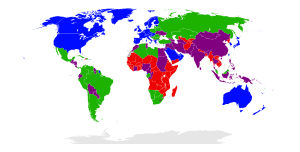As we celebrate the coming year with hope and optimism for change and progress, let us look at the video clip below to remind us, despite the apparent global convulsion due to the flawed economic paradigm of neoliberalism, how much the world has progressed across centuries. The presentation by Hans Rosling, a Swedish medical doctor, academic, statistician and public speaker, can serve as inspiration of how much innovation and technological change can push nations from the brink of poverty towards modernity.
The trajectory of growth (and how they sort of "converge") reminds me of the Solow–Swan model (also known as the exogenous growth model and the neoclassical growth model) - a model of a long-run economic growth. The model was developed independently by Robert Solow and T. Swan from the earlier Harrod-Domar model used to explain an economy's growth rate in terms of the level of saving and productivity of capital.
 |
| Conditional Convergence - Solow Swan Model |
 Image via Wikipedia
Image via WikipediaEmpirical evidence still needs to be gathered though, and we yet have to confront the intrinsic limitations of the neoclassical framework. For instance, we have to take into account the leapfrogging of several countries like Japan and South Korea which doesn't conform to the model. Also, Solow-Swan suffers from major theoretical limitations, which makes it inapplicable for predicting future trends. It is for this reason that endogenous growth models have been developed, which can be a different topic for this blog another day.

2 comments:
It's nice reading your blog. And it was nice meeting you last night. :)
Thanks JJ, I'll be putting thenutbox in my blog roll.:-)
Post a Comment